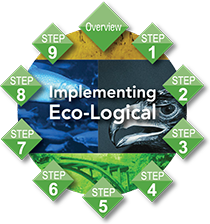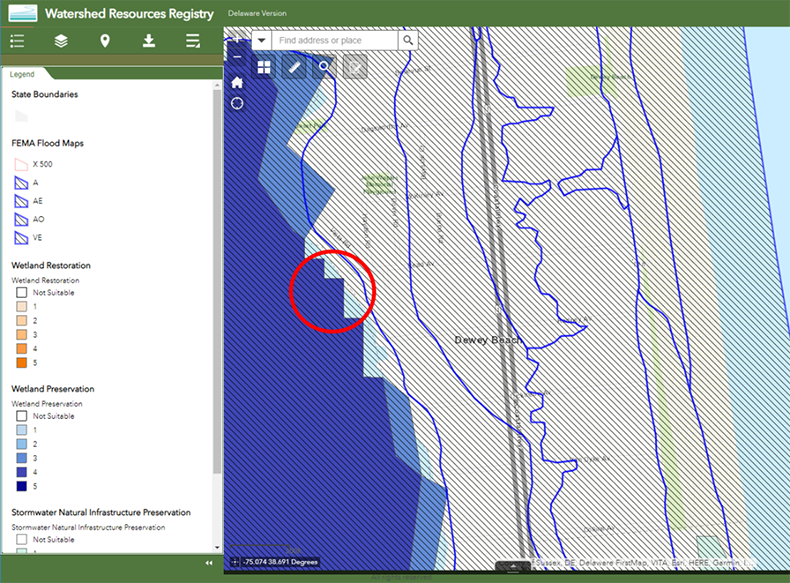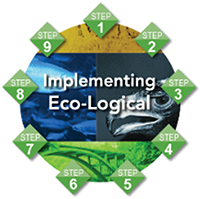Implementing Eco-Logical Can Improve Infrastructure Resilience to Extreme Weather

Figure 1: Mechanically stabilized earth. Photo credit: Oregon DOT
Eco-Logical has grown in use and awareness since its launch in 2006. Demonstrated by case studies, Eco-Logical has helped agencies to strengthen partnerships, decrease permit processing times, and cost.
Printer-friendly PDF →

The Eco-Logical Approach
Eco-Logical’s nine steps organize how agencies can partner and integrate plans to identify environmental priority areas and ecological considerations in project planning and delivery. Agencies can apply the steps in order or independently of each other.
All steps are featured in this case study:
Step 1:
Build and strengthen collaborative partnerships and vision
Step 2:
Characterize resource status and integrate natural environment plans
Step 3:
Step 4:
Assess effects on conservation objectives
Step 5:
Establish and prioritize ecological actions
Step 6:
Develop crediting system
Step 7:
Develop programmatic consultation, biological opinion, or permit
Step 8:
Implement agreements, adaptive management and delivery projects
Step 9:
Update REF and plan
What is Eco-Logical?
Eco-Logical articulates a vision that endorses ecosystem-based avoidance, minimization, and mitigation through integrating data, plans, design, and reviews across agency and disciplinary boundaries in developing infrastructure projects—organized into nine steps. Eco-Logical accelerates project delivery and improves environmental outcomes by bringing together transportation agencies and natural resource managers to identify and agree upon areas for environmental restoration ahead of time, such that when it is time to plan and build highway projects, stakeholders on both sides have already agreed upon environmental mitigation actions at the programmatic level, which can then be implemented at the project level.
How Important is Resilience?
Increased flooding from more frequent and intense precipitation events, sea level rise, and stronger coastal storms threatens Federal Highway Administration (FHWA) investment in highway infrastructure as well as public safety, mobility, and economic activity. The U.S. Department of Transportation (USDOT) Strategic Plan states that “USDOT will increase its effectiveness in ensuring that infrastructure is resilient enough to withstand extreme weather.”
FHWA requires risk/resilience to be included in:
What is the connection between Eco-Logical and Resilience?
Natural and nature-based features such as marshes, reefs, dunes, and beaches, protect upland infrastructure like highways from erosion, waves, and flooding. The Eco-Logical framework can be used to identify conservation or restoration opportunities that will provide both resilience and environmental benefits. The Regional Ecosystem Framework (REF), developed in Step 3 of the Eco-Logical approach, typically consists of GIS layers identifying natural resources for conservation and restoration. It may also include layers on hazards such as flooding and sea level rise. This information can be combined to identify sites for ecosystem restoration projects that could provide both environmental and resilience benefits. In addition, Eco-Logical can establish a crediting system for restoration projects that focus on resiliency and qualify for compensatory mitigation credit (Step 6).
Example: Connecting Eco-Logical and Resilience
FHWA’s project, Nature-based Resilience for Coastal Highways, provides research and technical assistance to enable transportation agencies to use natural and nature-based features to improve the resilience of transportation systems, and includes information on how to leverage the Eco-Logical process in doing so. While the following example did not follow the steps of the Eco-Logical approach directly, the process exemplifies many of the principles of Eco-Logical and therefore offers lessons to Eco-Logical practitioners.
Delaware Department of Transportation (DelDOT)
Projected Timeline: 12/2016 - 12/2019
Coastal Green Infrastructure to Enhance Resilience of State Route 1, Delaware
Estimated Project Budget: $173,209
Overview: DelDOT developed conceptual designs for nature-based solutions to protect two areas susceptible to flooding and erosion, the Read Ave stormwater outfall from State Route 1 (Coastal Highway) and the National Guard site. DelDOT, along with partners, led an investigation into methods and practices to identify areas of high vulnerability along the SR 1 corridor and to develop approaches to protect this critical transportation asset. DelDOT utilized existing GIS data and conducted a vulnerability assessment to identify where wetland restoration priority areas overlapped with flood zones. The Read outfall is circled in red in Figure 2, a screenshot of the Delaware Water Resources Registry. The project is in an area identified for wetlands preservation (blue) and in a flood hazard area (dashed lines).

Figure 2: Watershed Resources Registry - Delaware Version. Source: DelDOT
Key Results: DelDOT designed a nature-based solution consisting of marsh, dune, oyster reef, and rock breakwater features, as well as a tidal flap on the stormwater outfall for the Read Ave site. The primary benefits of the proposed adaptations are stabilized shoreline areas and reduced chronic localized flooding, especially associated with backflow high-tide and wind-driven events. Benefits also include an increase in ecological value associated with enhancing and expanding the coastal marsh area and implementing the oyster bags.
For More Information

Contacts
David Williams
Eco-Logical Program Lead
FHWA Office of Project Development and Environmental Review
(202) 366-4074
David.Williams@dot.gov
Resources
Tina Hodges
Environmental Protection Specialist
FHWA Sustainable Transportation and Resilience
(202) 366-4287
Tina.Hodges@dot.gov

